✨ Scandinavian winter: how holidays in Sweden differ from Norway, Denmark and Finland
✨ Sweden and its ‘holiday neighbours’
When we say ‘Scandinavia in winter,’ the same set of images immediately comes to mind: snow, lights on the streets, warm light from windows, a mug of hot mulled wine, and a fair somewhere by the water. From a distance, Sweden, Norway, Denmark and Finland seem almost identical in atmosphere.
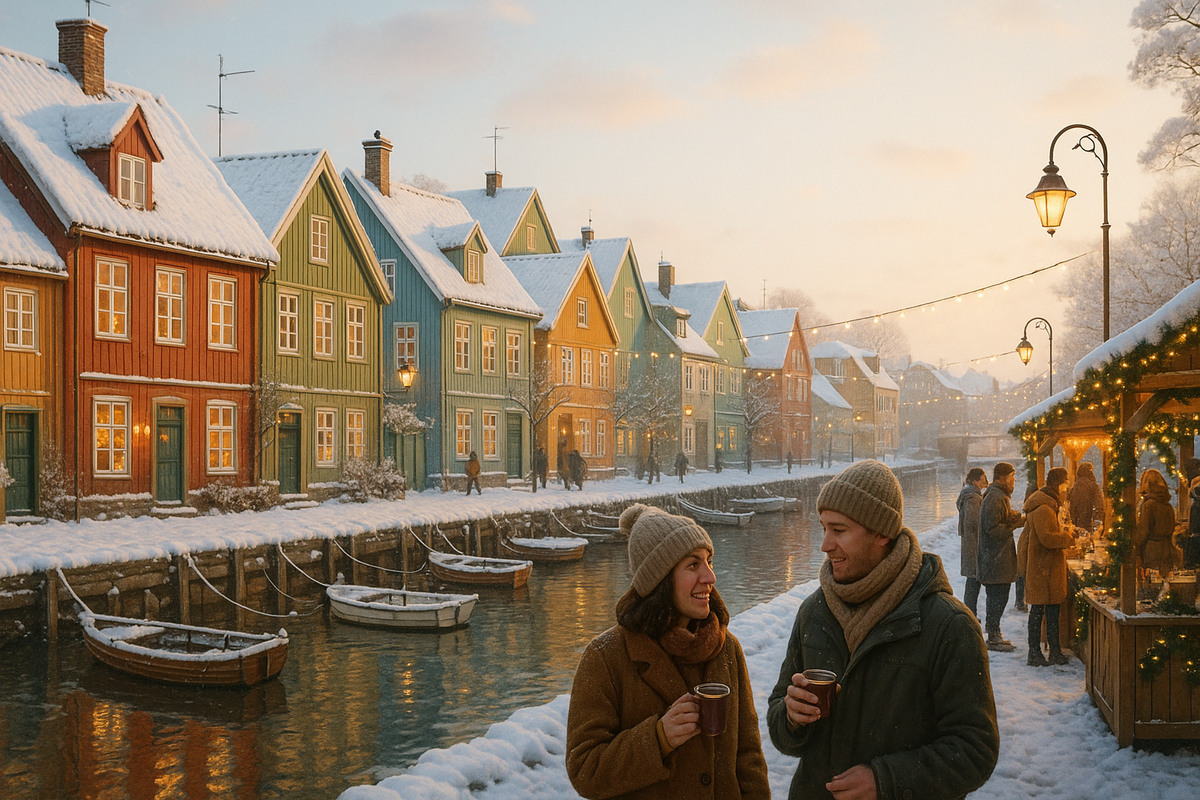
But when you get closer, it turns out that each country has its own unique characteristics. In some places, Christmas is quieter and more family-oriented, while in others, New Year's Eve is noisier and more boisterous. Some places focus on lights and cafés, while others focus on mountains, skiing and snow-covered cottages.
In this article, we look at winter holidays through the prism of Sweden and compare it with its neighbours — Norway, Denmark and Finland (yes, formally it does not always fall within ‘Scandinavia’, but for tourists it is one region). The text will be useful for those who:
- have already visited one of these countries in winter and are now choosing their next destination;
- are planning a combined trip to Scandinavia;
- or simply want to understand how the ‘Swedish winter’ differs from the Norwegian, Danish and Finnish winters — even though everything looks the same from the outside.
❄️ What everyone has in common: Christmas in the north in general
Before looking for differences, it is useful to recognise that the Scandinavian countries share a common ‘framework’ for winter holidays. Historically, the region is linked by common Christian (mainly Lutheran) traditions, and the calendar is very similar everywhere: Advent, Christmas centred on 24 December, Christmas holidays, New Year and January holidays.

In all countries, Christmas is the main family holiday of winter. Plans are made around it, holidays are taken for it, and homes and tables are prepared for it. New Year's, on the other hand, is perceived more lightly: as a pleasant evening with friends, dinner, fireworks, and a feeling of a new beginning, but without the same ‘sacred’ weight as Christmas.
Outwardly, the picture is also very similar:
- winter lights in cities and small towns;
- Christmas markets with hot drinks and handmade souvenirs;
- something like mulled wine in different local variations;
- an emphasis on cosiness at home: candles, textiles, warm lighting, lots of wood;
- short daylight hours, which make lights and interior design a matter of survival rather than just decoration.
From a tourist's point of view, this means that you will find the basics everywhere: there will also be markets, cosy cafes, houses with lights, warm drinks in your hands and the desire to stay wrapped up in your scarf.
💡 If you have been to one Scandinavian country for Christmas, you will not get lost in another — but the details will surprise you. It is in the nuances, rather than the ‘framework’ of the holidays, that the character of Sweden, Norway, Denmark and Finland is revealed.
🗓 Calendar: it's the 24th for everyone, but not in the same way
| Date | Sweden | Norway | Denmark | Finland |
|---|---|---|---|---|
| 24 December | Julafton – the main Christmas evening: Kalle Anka at 15:00, family dinner, julbord, Jultomten and gifts. | Family Christmas dinner, gifts, often with an important role for church and a “cabin in the mountains” or close to nature. | Family evening with Christmas dinner, pork/duck, lots of candles and hygge-style décor. | A strong family-centred celebration, Joulupukki (the Finnish “Santa”), often sauna and Christmas dinner. |
| 25–26 December | Calm Christmas days: visits to relatives, minimal errands, many places closed or with reduced opening hours. | Continuation of Christmas: family visits, rest, time in nature; life moves slowly with few business activities. | Christmas holidays, meeting relatives, long lunches and dinners, a relaxed pace. | Festive days off, time for family, guests, walks and quiet rest after the main evening. |
| 31 December | Nyårsafton: dinners at home or in restaurants, parties, Skansen and city squares, fireworks at midnight. | Dinner, meeting friends, fireworks in towns and by the fjords, a festive feeling but without the “sacred” weight of Christmas. | A louder New Year: parties, town squares full of people, lots of fireworks, especially in the big cities. | Dinners, gatherings, fireworks; often combined with winter activities and relaxation in nature or in the sauna. |
| 1 January | Official public holiday, a “do-nothing day”: reduced opening hours for shops and public transport. | A quiet day off after a night of fireworks, a slow start to the year, limited opening hours for services. | Public holiday, many places are closed or open late, life gradually returns to its normal rhythm. | Rest after the festivities, late breakfasts, walks, reduced opening hours for public places and transport. |
If you only look at the dates, it seems that everything is organised in the same way in all countries: the main evening is 24 December, followed by several Christmas days, then New Year's Eve and the first day of January. But in terms of feel, the Swedish Julafton often seems even more structured and ‘ritualistic’ than its neighbours, with its own set of media habits (Kalle Anka), visual codes (stars and candlesticks in windows) and a long continuation of the season until mid-January.
In Norway, there is a stronger connection between Christmas and nature and the mountains, in Denmark — with hygge and urban interior comfort, and Finland adds to this the image of ‘Santa Claus' homeland’ and the important role of the sauna.
🕯 Sweden: Christmas as a long season with its own special touches
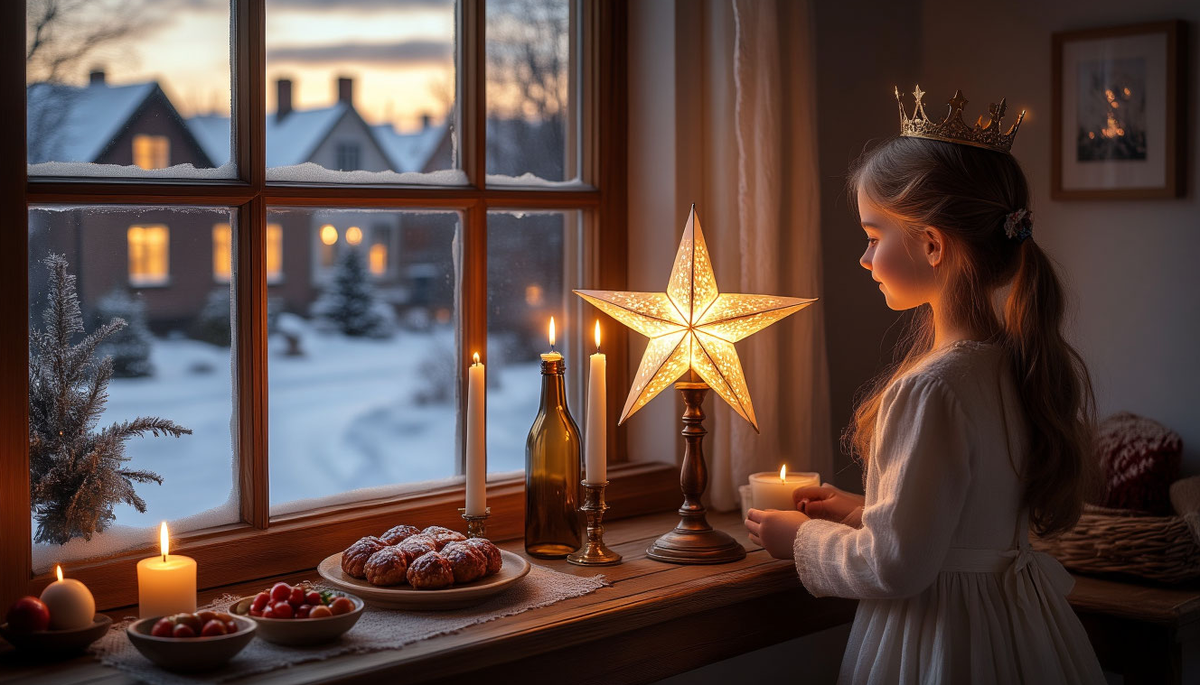
In Sweden, winter feels like one long Christmas season, with several very recognisable details:
- Advent and lights in the windows. Stars and electric candlesticks in windows are almost a must. They immediately convey the message: ‘This is Sweden, and it's already winter.’
- Saint Lucia's Day (13 December). Morning processions with candles and songs, white clothes, Lucia's wreath — there is nothing of this scale and form among Sweden's neighbours.
- Kalle Anka at 3 p.m. on Julafton. The evening of 24 December literally ‘begins’ with Disney cartoons — a rare example of a common media ritual that is still alive throughout the country.
- Christmas table and drinks. Julbord, Christmas ham, meatballs, Janssons frestelse, plus non-alcoholic julmust as a separate symbol of Swedish holidays.
- The long tail of the holidays. The Christmas feeling lasts until 13 January (St. Knut), when the Christmas tree is officially taken down and the decorations are put away.
🏔 Norway: mountains, snow houses and your own julebord
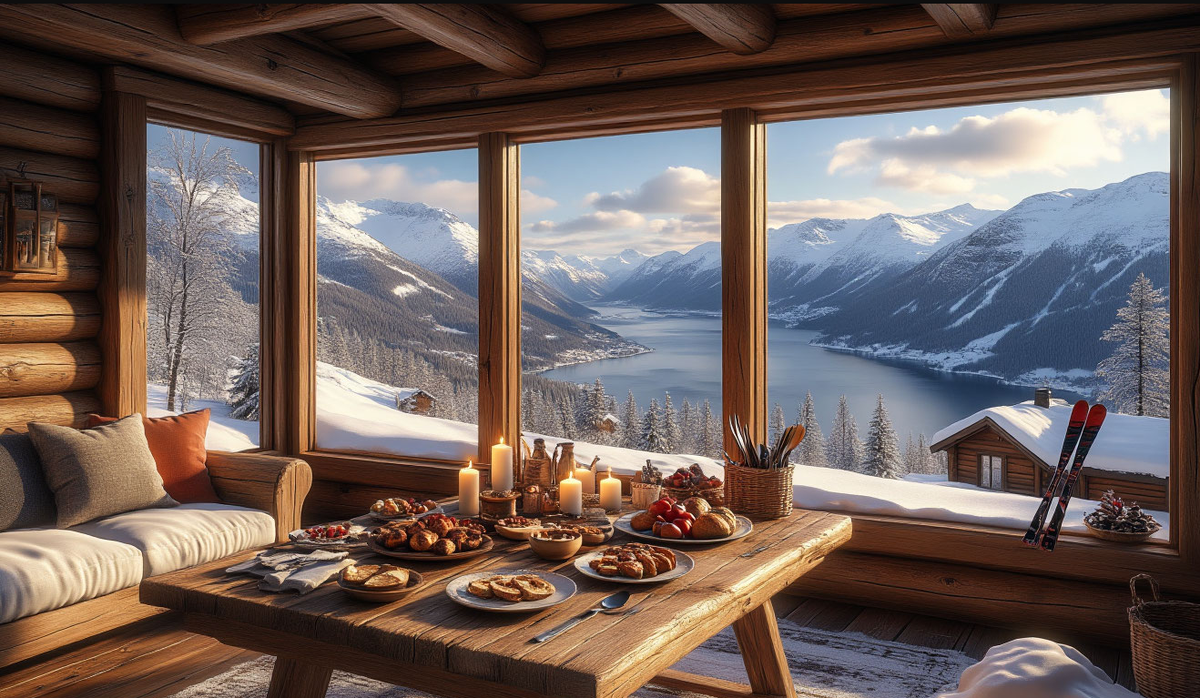
In Norway, the winter holiday calendar is very similar to Sweden's, but the image in people's minds is different:
- Focus on nature. Christmas and New Year are often associated not only with lights in cities, but also with mountain huts, fjords, skiing and snow. Many people leave the city for cottages closer to nature.
- Julebord in Norwegian. Norwegian julebord is a corporate party, a gathering with friends, and a family dinner. The format is similar to the Swedish ‘Christmas table,’ but the selection of dishes and the atmosphere are slightly different, with a strong influence from local products and regional traditions.
- Winter as a sporting season. The holidays are smoothly woven into the general winter rhythm: skiing, trips to the mountains, active outdoor recreation. The season feels more ‘broken up’ by activities, rather than one long Christmas stream.
- What tourists feel. Unlike Sweden, where media rituals and lights in windows are very noticeable, Norway is perceived more as being about nature and snow. There is less Kalle Anka and Lucia, and more of a ‘winter postcard’ feeling with fjords and houses under the snow.
🕯 Denmark: hygge, mild winter and city holidays

In Denmark, winter holidays feel different because of the climate:
- Mild winter. Snow is much less guaranteed here than in Norway or northern Sweden. The atmosphere is not based on a ‘snowy fairy tale,’ but on lights, shop windows and interiors.
- Hygge in its purest form. Danish Christmas is all about maximum cosiness indoors: candles, lamps, warm blankets, wooden furniture, small cafés where you want to sit for hours. Everything revolves around the feeling of ‘we are good here and now.’
- Julefrokost. An important part of the season is Christmas feasts with colleagues and friends, not just with family. Julefrokost can be quite heavy on food and drink, with long conversations and jokes.
- New Year's Eve in Copenhagen. On 31 December, the capital comes alive: squares, fireworks, noisy crowds, sometimes with a slightly more ‘boisterous’ atmosphere than in neat Sweden. If you want a more relaxed and lively New Year's Eve in a Scandinavian city, Copenhagen is one of the obvious choices.
🎅 Finland: Joulupukki, sauna and a Christmas fairy tale in Lapland
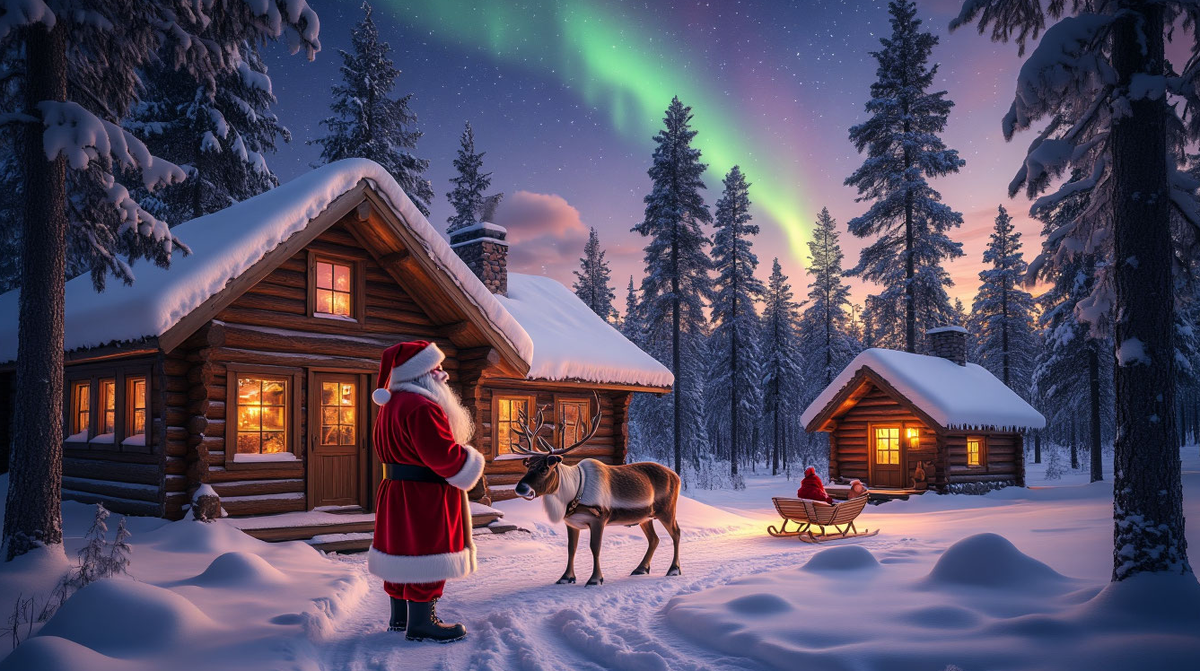
In Finland, winter holidays are easily associated with the ‘official home of Santa Claus’:
- Joulupukki. The Finnish version of Santa Claus, Joulupukki, is one of the country's main symbols. The image is actively promoted: Santa Claus Village, post office, meetings with children. For tourists, it's a direct route back to childhood.
- Sauna as part of the ritual. Unlike its neighbours, the sauna here is not just a winter attribute, but an important element of both Christmas and New Year's Eve. For many families, it is normal to go to the sauna before the festive dinner or the next morning.
- Focus on the north and Lapland. Finland actively combines Christmas and winter tourism: Lapland, snowy landscapes, the northern lights, dog and reindeer sleds, glass igloo hotels.
- How it differs from Sweden. If the Swedish winter is more about the long season of lights, Advent and family cosiness, then the Finnish winter, especially in Lapland, feels like a ‘packaged Christmas fairy tale’ for those who want maximum snow, Santa Claus and winter activities in one trip.
🍽 Tables and drinks: julbord, julebord and julefrokost
All Scandinavian countries have their own version of the ‘Christmas table’: lots of dishes, a shared buffet or a long family dinner, with the same classics repeated year after year. But the range of flavours and accents is slightly different — this is clearly visible when you break them down by country.
| Country | Typical dishes | Drinks and specifics |
|---|---|---|
| Sweden (julbord) | Pickled herring, gravlax and other salmon dishes, julskinka (Christmas ham), meatballs, small sausages, the casserole Janssons frestelse, cheese, bread, pastries and sweets. | Julmust as a symbol of Swedish holidays, glögg (hot spiced drink), beer, aquavit. The spread is most often served at Christmas; New Year’s is less “culinarily special”. |
| Norway (julebord) | Different regional versions: ribbe (roasted pork ribs), pinnekjøtt (salted and dried lamb), fish dishes, sausages, potato side dishes and traditional desserts. | Beer and aquavit, Christmas beer varieties, gløgg. Julebord can be office parties, gatherings with friends or family-style dinners, often spread out over the whole of December. |
| Denmark (julefrokost / julebord) | Rich and hearty dishes: pork, roasted duck or goose, potatoes in various forms, herring, cold cuts, smørrebrød open sandwiches, rice pudding risalamande with an almond “prize” hidden inside. | Beer, aquavit, gløgg. Julefrokost is often a long feast with colleagues or friends, sometimes quite “lively” in mood. |
| Finland (joulupöytä) | Ham, fish dishes, root vegetable casseroles, potatoes, salads, Christmas baking, spiced biscuits, rice porridge/pudding with a “hidden” almond inside. | Mulled-wine-like glögi, beer and other drinks. The dinner is often complemented by a visit to the sauna before or after the meal. |
The idea is the same in all countries: lots of small dishes, a shared table and a ‘set of childhood flavours’ that repeats itself year after year. But if you want the Swedish experience, look for the words julbord and julmust — they best convey the local character of the holiday.
🎆 City vs nature: what holidays look like in different countries
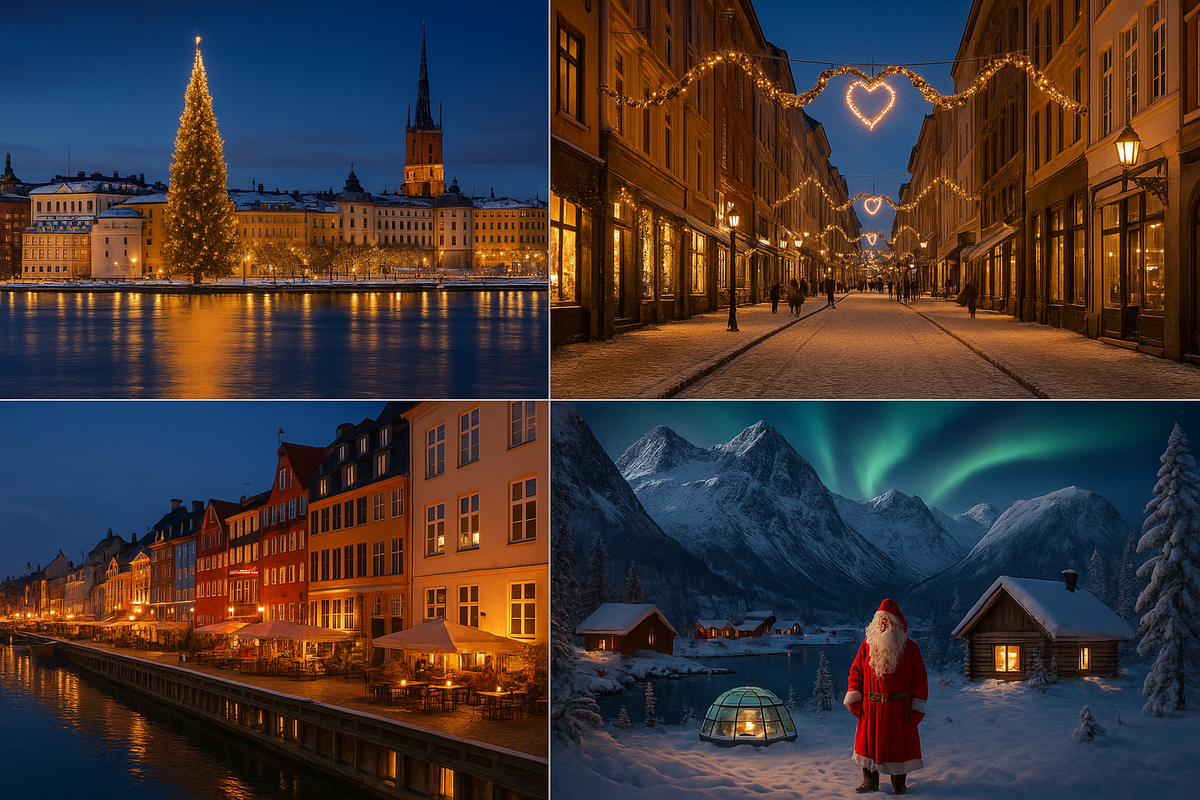
In Scandinavian countries, the same holiday can be experienced in two very different settings: the city with its lights and fairs, or nature with its cottages, snow and silence. Each country has its own balance between these options.
Sweden: cities + forest cabins
In Sweden, winter is felt both in the cities and beyond:
- Stockholm, Gothenburg, Malmö — these are embankments, lights, fairs, cosy cafes, restaurants with julbord, museums and Christmas shop windows.
- A couple of hours by car or train and you are already in a forest cabin, by a lake or in a small town, where you can spend the evening by the fireplace and take a walk in the snow in the morning.
Sweden offers a comfortable combination: you can live in the city and then ‘escape’ into nature for a couple of days.
Norway: fjords, mountains and winter postcards
Norway is more strongly associated with nature than any other country:
- Cities such as Oslo, Bergen and Trondheim are beautifully decorated and pleasant to walk around, but many people want to go further — to the fjords and mountains.
- Winter holidays easily turn into stories about cottages in the snow, skiing, views of mountains and fjords.
If you want your photos to feature not only garlands but also ‘austere beauty’, Norway is the place to go.
Denmark: pure urban cosiness
Denmark has a different balance:
- The main attraction is Copenhagen with its streets, canals, cafes, Tivoli, restaurants and candlelit evenings.
- There are no mountains or fjords, the focus is on the urban format: interiors, hygge, walks, bars, fairs.
This is a good choice if you want a winter holiday in a European city, but with a very Scandinavian feeling of cosiness.
Finland: Helsinki and a fairy tale in the north
Finland seems to be divided into two winter universes:
- Helsinkiis a city of lights, markets, cafes and sea air.
- The north and Rovaniemi are pure Christmas fairy tales: snow, Lapland, Joulupukki, the northern lights, snowmobiles, reindeer and glass houses.
If you are looking for ‘fairy tales and activities’, the Finnish north can feel completely different from Swedish cities or Norwegian fjords.
🧭 Tourist impressions: where it will be quiet and where it will be noisy
From a tourist's perspective, the difference between the countries is felt not only in the food and decor, but also in how ‘appropriate’ you feel within the holiday.
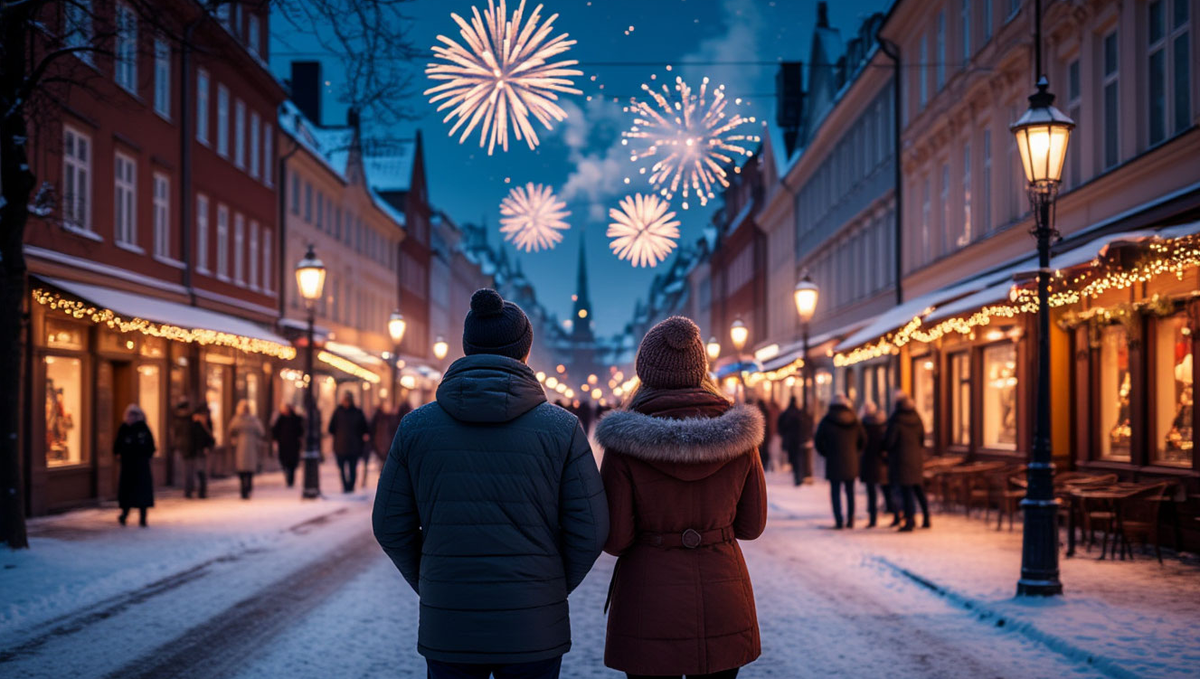
Where Christmas is quietest and most family-oriented
- Sweden. Julafton is very family-oriented and ‘homely’. On 24 December, the city seems to shut down: everything happens behind closed doors. It is better for tourists to come here to ‘observe from the sidelines’ and enjoy the atmosphere before and after, rather than wait for an invitation to someone else's living room.
- Norway. Similar to Sweden, but with a stronger sense of nature: many people go to cottages and the mountains. In the city, you can also see ‘emptiness’ at Christmas — and that's normal.
- Finland. Christmas is very intimate in families, but in Lapland, due to tourism, some of the programmes are tailored to guests, so there are more ‘open’ Christmas activities there.
- Denmark. It's also a family evening on the 24th, but due to the dense urban life and the julefrokost format, tourists feel a little less ‘closed off’.
Overall: Christmas in all countries is more of a private, family holiday, especially if you don't live there permanently.
What to expect on the 24th and 31st so you won't be disappointed
- 24 December (Christmas)
- Everywhere: quiet, many places closed, minimal city life.
- Sweden and Norway: as closed as possible, it is important for tourists to buy and book everything in advance.
- Denmark and Finland: slightly more chances to find places that are open, but still not a day for shopping and active nightlife.
- 31 December (New Year's Eve)
- Sweden. Cosy dinners, parties, Skansen and fireworks — it will be a celebration, but usually without the ‘total madness’ until morning.
- Norway. Similar format: dinner, friends, fireworks, beautiful views (especially by the water and in the mountains).
- Denmark. The most ‘our kind of’ noisy New Year: Copenhagen with its squares, bars, and lots of fireworks.
- Finland. In the cities — a classic northern New Year with fireworks; in the north, you can combine it with nature and winter activities.
If you want a quiet, very family-oriented Christmas and a long season of lights, it makes more sense to focus on Sweden and Norway. If you want more urban hustle and bustle and a New Year's Eve that is ‘closer to ours’, look towards Copenhagen, large Norwegian cities, or combine Finland with Lapland.
🔚 How to choose ‘your’ Scandinavian winter
All Scandinavian countries have similar winter holidays: Christmas is about home and loved ones, New Year's Eve is about light-hearted celebrations and fireworks, and in between there are lights, fairs and long dark evenings spent cosily indoors. But Sweden still feels special: here, the long light season from the first Advent to St. Knut, Lucia on 13 December, stars and candlesticks in the windows, the tradition of watching Kalle Anka and the particularly intimate, family-oriented Julafton, around which the whole winter is built, are very noticeable.

It is easier to choose a country based on your mood. If you want more cosiness and lights, look towards Sweden. If you are drawn to mountains and postcards with fjords, it is logical to think about Norway. If you want a noisy city New Year, take a look at Denmark. If you dream ofSanta Claus, Lapland and the northern lights, Finland is almost the obvious choice.
And if your heart desires ‘everything at once’, you can put together a combined itinerary: combine Stockholm and Copenhagen, for example, or Sweden with Norway or Finland. When planning your trip, take a look at our sections on Sweden, Norway, Denmark and Finland — by city, region, fair and cosy places. This will make it easier to put together your ideal Scandinavian winter from the elements that appeal to you most.
❓ FAQ: short answers about the differences
Yes. The general Scandinavian ‘framework’ is similar, but in Sweden there is a stronger sense of the long season of lights (Advent, stars and candlesticks in the windows), Lucia on 13 December and the media ritual of Kalle Anka at 3 p.m.. In Norway, the emphasis is more on the mountains and nature, while in Sweden it is on light, rituals and a long ‘aftertaste’ until 13 January.
Most of all in Sweden and Norway. On 24 December, the cities really empty out, with everyone retreating to their private homes and cottages. In Denmark and Finland, the format is the same, but due to urban density (Denmark) and tourism (Finnish Lapland), it is slightly easier for tourists to find ‘life’ around them.
Copenhagen feels the most ‘like home’: lots of people on the streets, squares, fireworks, bars, a slightly chaotic atmosphere. Norwegian and Swedish cities also celebrate, but they are often calmer and more organised. Finland offers a compromise: the capital plus the opportunity to go to the countryside or Lapland.
In terms of the ‘postcard’ feel with snow and nature, Norway (mountains, fjords, cottages) and northern Sweden/Finland win. Denmark is more often associated with a mild winter without guaranteed snow. If your goal is snow, the north and, possibly, the northern lights, it is better to look at Norway, Finnish Lapland and northern Sweden, rather than Copenhagen.
For a concentrated Christmas fairy tale with Santa Claus, it makes the most sense to go to Finland, especially to the Rovaniemi and Lapland area: Joulupukki, Santa Claus Village, sleigh rides, igloo hotels, the Northern Lights. Sweden offers a more ‘real’ family Christmas atmosphere, while Finland offers a packaged fairy-tale experience.
Sweden offers a very balanced mix:
- big cities with lights and culture;
- forest cottages and nature;
- a long, well-structured season from Advent to St. Knut;
- its own unique things: Lucia, Kalle Anka, julmust, a very readable visual code with stars and candlesticks.
This is a good ‘basic option’ for your first serious winter trip to Scandinavia.
Yes, and many people do just that:
- Sweden + Denmark (Stockholm and Copenhagen, ferry or train);
- Sweden + Norway (Stockholm + Oslo/Bergen);
- Sweden + Finland (Stockholm + Helsinki/north).
The main thing is to take public holidays into account: do not plan active travel on 24–26 December and 1 January, and book transport between countries in advance.
- Sweden: Stockholm, Gothenburg, Malmö — convenient, atmospheric, lots of lights and water.
- Denmark: Copenhagen — ideal for the ‘fly in, live in the centre, everything within walking distance’ format.
- Norway and Finland offer a vibrant urban experience, but often you want to ‘add nature’ and the logistics are a little more complicated.
If you don't want to be tied to a car and long journeys, Stockholm and Copenhagen are the most obvious ‘urban’ bases.
The right expectations will help everywhere: 24 December is not a ‘day for shopping and partying,’ but a day for quiet and your own plans.
It's a little easier psychologically in:
- Copenhagen and Helsinki — due to the urban structure and tourism;
- tourist areas of Lapland, where some of the programmes are specifically geared towards visitors.
But if you understand in advance that Christmas is not a ‘mass city holiday’ but a quiet family evening, you will not be disappointed in Sweden or Norway.
A rough guide:
- More cosiness and lights, a long season, a gentle pace → Sweden.
- Nature, mountains, cottages, snowy postcards → Norway.
- City life, bars, a noisy New Year → Denmark (Copenhagen).
- The tale of Santa Claus + active winter tourism → Finland (especially Lapland).
If in doubt, it's easiest to start with Sweden: it provides a good ‘gold standard’ for a Scandinavian winter, which is a convenient basis for comparing its neighbours.
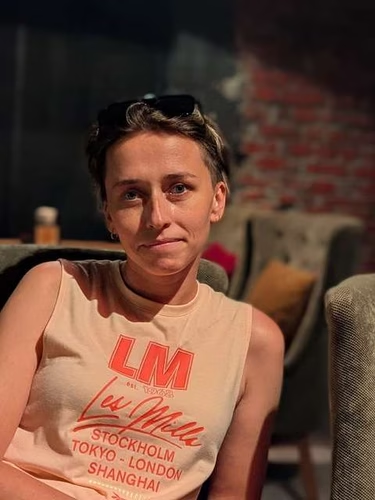



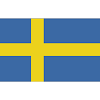
0 comments
Log in to leave a comment